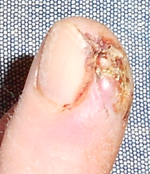Wound
A wound is classified as damage to the human or animal skin. Wounds can be either open or closed. Examples of open wounds include cuts, lacerations or puncture injuries. Contusions, hematomas or crush injuries are examples of closed injuries.
Open
- Incision: Clean cut wounds caused by a knife, glass or razor usually fall into this type of injury. The wound edges are cut cleanly with no ragged edges.
- Laceration: This type of wound has tear-like edges and is caused by blunt force trauma.
- Abrasions: The upper most edges of the epidermis is scraped off. This type of injury is usually caused by the skin surface sliding across a rough surface.
- Puncture: The skin is punctured by a sharp object such as a nail or sewing needle.
- Penetration: When an object such as a knife enters and exits the skin.
- Gunshot: A projectile typically caused by a bullet or similar object entering or going through the body. Sometimes there will be an entry and exit wound in this type of injury.
Closed
- Contusions: This type of wound is commonly known as a bruise. Blunt force trauma damages tissue under the skin.
- Hematomas: Blood vessels are damaged causing blood to collect under the skin.
- Crush injury: Extreme force is applied over an area causing damage. Slamming a finger in a car door or dropping a heavy object onto a foot are examples of crush injuries.[1] [2]
Wound treatment
A medical professional will usually evaluate the wound and stop bleeding. The date, time and mechanism of injury will be documented. A patient history will be obtained. The wound is investigated to determine whether muscle, tendons, nerves, blood vessels or bone were damaged.
The wound is irrigated and sutured, if required. Tissue adhesive or Steri-strips may also be used to close a wound, if needed.
Depending on the suture location, sutures can be removed between three to 21 days. Facial sutures are usually removed between three to five days while palm sutures may remain in place up to 21 days.[3]
A tetanus immunization may be required depending on the type of injury and immunization status of the patient.
References
- ↑ Types & Causes of Open Wounds (2008-10-15). Retrieved on 2011-11-28.
- ↑ Wound: Wound Healing (2008-10-15). Retrieved on 2011-11-28.
- ↑ Forsch, MD, Randall (2008-10-15). Essentials of Skin Laceration Repair. American Family Physician. Retrieved on 2011-11-28.
